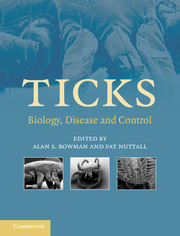Book contents
- Frontmatter
- Contents
- List of contributors
- Preface
- 1 Systematics and evolution of ticks with a list of valid genus and species names
- 2 The impact of tick ecology on pathogen transmission dynamics
- 3 Tick salivary glands: the physiology of tick water balance and their role in pathogen trafficking and transmission
- 4 Tick saliva: from pharmacology and biochemistry to transcriptome analysis and functional genomics
- 5 Tick toxins: perspectives on paralysis and other forms of toxicoses caused by ticks
- 6 Tick lectins and fibrinogen-related proteins
- 7 Endocrinology of tick development and reproduction
- 8 Factors that determine sperm precedence in ticks, spiders and insects: a comparative study
- 9 Tick immunobiology
- 10 Saliva-assisted transmission of tick-borne pathogens
- 11 Lyme borreliosis in Europe and North America
- 12 Viruses transmitted by ticks
- 13 Babesiosis of cattle
- 14 Theileria: life cycle stages associated with the ixodid tick vector
- 15 Characterization of the tick–pathogen–host interface of the tick-borne rickettsia Anaplasma marginale
- 16 Emerging and emergent tick-borne infections
- 17 Analysing and predicting the occurrence of ticks and tick-borne diseases using GIS
- 18 Acaricides for controlling ticks on cattle and the problem of acaricide resistance
- 19 Anti-tick vaccines
- 20 Anti-tick biological control agents: assessment and future perspectives
- 21 Pheromones and other semiochemicals of ticks and their use in tick control
- Index
- References
15 - Characterization of the tick–pathogen–host interface of the tick-borne rickettsia Anaplasma marginale
Published online by Cambridge University Press: 21 August 2009
- Frontmatter
- Contents
- List of contributors
- Preface
- 1 Systematics and evolution of ticks with a list of valid genus and species names
- 2 The impact of tick ecology on pathogen transmission dynamics
- 3 Tick salivary glands: the physiology of tick water balance and their role in pathogen trafficking and transmission
- 4 Tick saliva: from pharmacology and biochemistry to transcriptome analysis and functional genomics
- 5 Tick toxins: perspectives on paralysis and other forms of toxicoses caused by ticks
- 6 Tick lectins and fibrinogen-related proteins
- 7 Endocrinology of tick development and reproduction
- 8 Factors that determine sperm precedence in ticks, spiders and insects: a comparative study
- 9 Tick immunobiology
- 10 Saliva-assisted transmission of tick-borne pathogens
- 11 Lyme borreliosis in Europe and North America
- 12 Viruses transmitted by ticks
- 13 Babesiosis of cattle
- 14 Theileria: life cycle stages associated with the ixodid tick vector
- 15 Characterization of the tick–pathogen–host interface of the tick-borne rickettsia Anaplasma marginale
- 16 Emerging and emergent tick-borne infections
- 17 Analysing and predicting the occurrence of ticks and tick-borne diseases using GIS
- 18 Acaricides for controlling ticks on cattle and the problem of acaricide resistance
- 19 Anti-tick vaccines
- 20 Anti-tick biological control agents: assessment and future perspectives
- 21 Pheromones and other semiochemicals of ticks and their use in tick control
- Index
- References
Summary
INTRODUCTION
Anaplasma marginale is a tick-borne pathogen that causes the disease anaplasmosis in cattle (Bram, 1975; Ristic, 1968). This pathogen is classified within the Order Rickettsiales which was recently reorganized into two families, Anaplasmataceae and Rickettsiaceae, based on genetic analyses of 16S rRNA, groELS and surface protein genes (Dumler et al., 2001) (Table 15.1). Organisms of the family Anaplasmataceae are obligate intracellular organisms that are found exclusively within membrane-bound vacuoles in the host cell cytoplasm. Phylogenetic analyses consistently supported the formation of four distinct genetic groups of the organisms: (1) Anaplasma (96.1% similarity), (2) Ehrlichia (97.7%), (3) Wolbachia (minimum of 95.6% similarity) and (4) Neorickettsia (minimum of 94.9% similarity) (Dumler et al., 2001). The genus Anaplasma currently includes the three pathogens of ruminants, A. marginale, A. centrale and A. ovis, together with A. bovis (formerly Ehrlichia bovis), A. phagocytophilum (formerly E. phagocytophilum, E. equi and the HGE agent), and A. platys (formerly E. platys). Aegyptianella, also included in this genus, was retained as a genus incertae sedis due to lack of sequence information.
Anaplasma marginale is distributed worldwide in tropical and subtropical regions of the New World, Europe, Africa, Asia and Australia. Several geographical isolates of A. marginale have been identified in North and South America, which differ in morphology, protein sequence, antigenic characteristics and their ability to be transmitted by ticks (Smith et al., 1986; Wickwire et al., 1987; Allred et al., 1990; Rodriguez Camarilla et al., 2000; Palmer, Rurangirwa & McElwain, 2001; de la Fuente et al.
- Type
- Chapter
- Information
- TicksBiology, Disease and Control, pp. 325 - 343Publisher: Cambridge University PressPrint publication year: 2008
References
- 1
- Cited by



